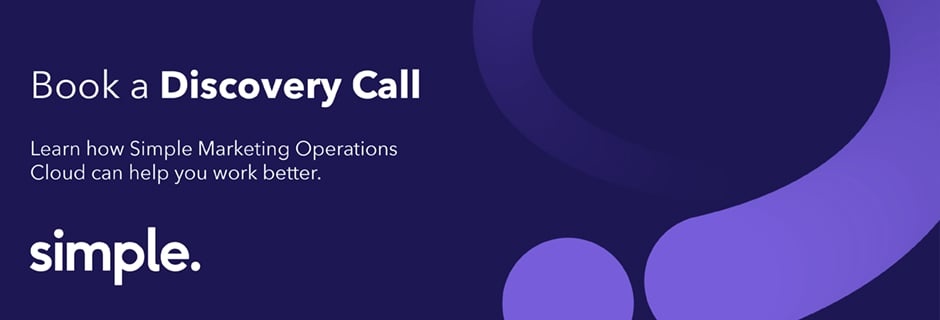Performance at the Heart of Simple’s Customer Success Philosophy
What do investment management and the customer success team at Simple have in common? Delve into the background of Simple’s chief customer officer Jenn Johnson and it becomes clear how a focus on setting strategic objectives and exceeding targets is benefiting Simple’s marketing performance customers.
What was your first job?
I started out as an investment manager in global high-yield corporate debt, analysing small high risk companies. Following a series of takeovers I came to work at Colonial First State, which was later owned by Commonwealth Bank of Australia, Australia’s biggest banking group.
In this venture capital-type investment, you have to figure out which companies are too high-risk, and which ones present good investment opportunities. You want to make sure they’re going to be able to pay their debts but also grow and achieve their goals. I favoured companies that had clear objectives, targets, action plans and metrics that were consistently tracked to show progress towards those targets.
It was fun trying to outperform the index and my competitors. I liked the analysis and the achievement.
After taking some maternity leave I led some strategic projects for the investment team including improving our investment disciplines, addressing new regulatory requirements, a hedge fund liquidation and new market entry strategies. This gave me an understanding of how our own business needed to run better, particularly with regard to risk management and the growth strategies being considered by our board.
How did you make the switch to marketing?
I completed the AICD company director’s course because I really enjoyed corporate strategy and helping companies achieve their goals. One thing that stood out for me though was that I needed a better grounding in one key area… marketing!
I’m a numbers and performance person, not a creative type, so I thought hard about how I could fill this gap in my knowledge. My search turned up a newly created role for an Executive Manager Strategy and Business Performance reporting to the Chief Marketing Officer at CBA.
A new CMO had just arrived with big aspirations to shake things up and get our house in order, and he was a big believer in metrics and accountability. He wanted a numbers person rather than a creative marketer. I was just the woman for the job!
Describe your introduction to marketing operations
This new role was fast-paced and extremely varied. As the inaugural and sole person in marketing operations, I was handed many of marketing’s problems to solve — and there were quite a few! I was also responsible for executing to a large and siloed team. I consider myself a tough cookie, and resilient, but this was hard work.
My CMO said ‘Go’ on about 10 different projects he didn’t have budget for and when we only got funding approved for a portion of it he turned to me and said, ‘Now find an ingenious way to get me the rest’.
We were going through a transition in marketing, deploying new online and social strategies, launching new products, re-branding, reviewing our agencies, building models to help optimise our media spend, closing the loop on analytics, and making metrics and reporting mandatory for everything.
The new Privacy Act, additional regulatory changes, a procurement review of all suppliers and an internal audit all needed to be managed.
To top things off, there were new productivity targets that meant I had to figure out how to do all this with less funding while helping the team achieve higher targets.
I tried to find some common ground for our issues: a way to manage the change, build efficient, repeatable processes, empower our people through visibility and accountability, build for growth and have a forum for implementing and changing behaviours.
What were some of your key priorities?
My main priorities initially were the stand-out issues of risk, compliance, and productivity, while incorporating the new directive from the CMO about visibility and accountability.
We wanted to minimise waste, and find better ways to achieve our marketing goals. All decisions were to be made through metrics and measurement, and targets were set for everything so we could improve our performance.
How did you approach marketing compliance?
The most pressing issue at the time was an internal audit of the marketing department. We were required to show the approval trail for 20 campaigns that were being spot-checked internally. We failed miserably!
Those approvals were all sitting in people’s emails, and many of those people had since moved on. With those we could track, we often found there were 20 or 30 emails that covered all the approvers and all the versions of a single piece of marketing.
I had to find a better way of handling approvals immediately. My short-term fix did not make me popular, to say the least. I made campaign managers drag all their approval emails into a Word document which then needed to be saved on a shared drive where audit could access and spot check it. It was fiddly and everyone hated it!
The audit required a sustainable, long-term solution. I did a search for appropriate partners and eventually got approval with my modest budget to build out the business requirements with Simple, with which we already had a relationship with for a local area marketing platform.
In traditional terms, I was looking for a Marketing Resource Management (MRM) platform, but I wanted to take it much further. In addition, the graphic design team also needed to replace its Digital Asset Manager (DAM). Simple’s platform could fulfil that function, so we were able to solve multiple problems with a single solution.
Read next: 10 Steps to Mastering Marketing Compliance Checklist
What kind of productivity gains did you achieve?
Our new productivity targets forced us to focus on how to be more efficient and effective. We set specific productivity goals for every team: the rules were you could not simply cancel activity, and whatever you changed had to get the same or better results than last year. One easy area we knew we could improve upon was the more efficient use of materials.
Owning, storing and having ready access to our own creative assets was the key to having the freedom and power to reuse our own assets so the Simple Library (DAM) facilitated this. We could also track metadata such as when licensed use of assets expired. The principle of re-use allowed us to cut down on creative expense and reinvest in media for improved returns on investment.
While some savings were incremental, they all contributed to a key shift in attitudes within the marketing department. For example, historically we had sent out a lot of mass direct mail-outs that could run to as many as eight pages. The team streamlined this to two pages, targeted only high-value prospects, and got the same result or better than we had before.
We focused on what we needed to stop doing in order to make room for higher-value activity. Everything was evaluated and classified ‘Stop’, ‘Change’ or ‘Continue’. No productivity initiative was too small: efficiency gains were incorporated into KPIs, and we tracked everything. Productivity became a source of pride as we celebrated big wins and small. It was amazing the savings you could find once the team was incentivised and rewarded to find them!
More significant benefits were found when we looked at how to maximise the media spend. Where we had previously run three creative campaigns a year for a particular product, the team opted to run just two, but run them for longer, reinvesting the creative savings into media spend. We also worked with our agencies and found big savings could be made if we booked our media schedule at least eight weeks in advance, increasing the spend on actual media time.
Read next: 20 Tips to Boosting Your Marketing Efficiency
What was your approach to process and planning?
A common complaint from marketers is that it takes too long to get marketing material live. We reviewed our end-to-end marketing process with the goal of improving speed to market. In the first Simple pilot we tracked eight campaigns and found they touched 108 people! In the end we onboarded 1200 users to Simple that either were in marketing or interacted with marketing.
Simple makes all the issues and touch points visible and trackable. We reviewed the participants, the steps and the content, and streamlined it all.
Poor briefs were identified as one of the root causes for rework. The review found this was also an opportunity to ensure every activity had clearly defined targets and approved results tracking. We developed a template and skilled the team in best practice briefs that reduced rework and approval times, resulted in stronger alignment to strategic objectives and required all results to be tracked.
All marketing teams can do planning better and we were no different. Budget, resource and campaign feasibility planning especially needed to improve. But equally important was the cadence and operating rhythm of the marketing lead team, including our internal communications and reporting, and development of the team culture through training, rewards and recognition.
Proper planning and the right lead team agenda can be the most powerful tools for aligning the entire marketing team to marketing performance goals. I believe it’s the uncomfortable conversations that arise when a problem is made visible through the right reporting that create the most change… and success.
Read next: One Simple Tip to End Marketing Planning Chaos
Any other learnings about marketing performance?
I worked on a really interesting project that aimed to optimise the bank’s media spend. We partnered with specialists from the US to build an analytics model that took five years of historical data over 100 touch points and helped us isolate which pieces of media were creating the biggest return for the bank.
The results were both fascinating and controversial as they exposed the products that were generating a poor return on their media investment and demonstrated how important brand support was.
Read next: How Marketing Operations Underpins Successful Digital Transformations in Marketing
Why did you join Simple?
I was proud of what we had achieved with Simple but I saw a great opportunity to take the work we were doing to the next level. I see Simple as a partner for performance. That’s the exciting part. The goal is to help our customers unlock big benefits so that it’s a no-brainer to partner with us.
I enjoy helping customers problem-solve and I really love the messy customers that present so much opportunity for improvement. Some of our customers openly admit that they have no process or a weak operating model and look to us to define best practices for them.
The quick wins are easy to spot right from the first session. In reality though, change doesn’t happen overnight so we start with the immediate benefits and build a maturity path.
How would you describe your customer success philosophy?
We are not achieving our goals unless our customers are improving their marketing performance. Our process is to be very clear on our customers’ objectives, then work with them to develop metrics that will uncover opportunities. We set targets, develop an activity plan that will shift the metrics and then set regular checkpoints to review progress.
We work with all levels of the business to deploy programs that support teams and help them to achieve their targets. I hire people in Simple’s customer success team who have that passion about being nurturing and supportive.
I have had customers say we’re not your typical technology vendor and I am proud of that. If my role as CCO of Simple was just to roll out technology, I wouldn’t be interested. I’m here to help businesses set up programs to change and improve their marketing performance.


